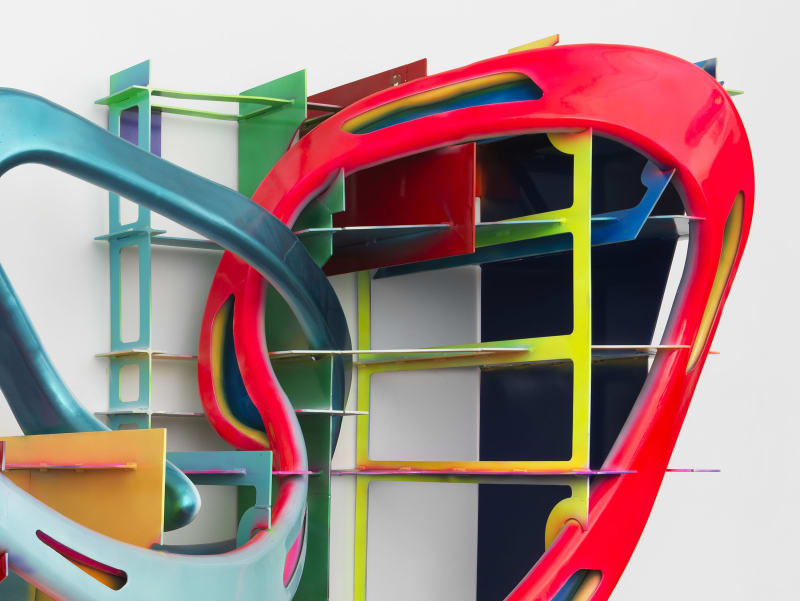BY CARLY OLSON
At Marianne Boesky Gallery in Chelsea, Frank Stella’s newest sculptures are clearly something to stop and gawk at. One 20-foot star—half silvery aluminum, half playground-like lattice—beckons all eyes in the room immediately. On another work, plumes of white fiberglass pour from an array of interlocking neon sheets, like a bookshelf come to life. Three giant, outdoor-friendly pieces show a smattering of multicolor abstractions stuck to panels of clear resin and perched high on metal poles. With a firm push, supervised gallerygoers can watch the masses spin.
This is not to say that the sculptures, which range from the monumental to the practical, are simple crowd-pleasers. The exhibition, “Frank Stella: Recent Work,” features nearly all new pieces that Stella created between 2016 and today: messy, experimental, and colorful works that longtime Stella fans will delight in. This work represents his latest chapter, transforming his motifs in painting into sculpture and bringing digital technology to the forefront.
“He’s entered this maximalist phase,” says Ricky Manne, a partner at the gallery. A quick look around the gallery shows jolts of fluorescent work leaping off the concrete walls. The white fiberglass globs that adorn many pieces in the exhibition are forms of smoke rings inspired by his work with the subject in the 1980s. (Stella then photographed his own cigar smoke and had the plumes fabricated; Manne cites them as some of the first 3-D prints ever made.) “Even though Frank 3-D-prints, and he’s been 3-D-printing for 30 years, it’s never been about 3-D printing,” Manne explains. “For him, whether it was fabrication with metal, aluminum, plastic, [or] steel, it’s about creating the form he had in mind, not the process.” Despite this allegiance to product over method, it’s clear by appearance alone that these new works have been touched by something digital. The fresh interpretations of the smoke rings, shiny forms reminiscent of smeared chewing gum with a latex-esque finish, live alongside the vivid metals, interlocking grids, and star forms throughout. Viewers are sure to be grounded by these shared motifs amid the arresting stimuli.
The concepts behind Stella’s celebrated geometric abstract paintings, his discrete stripes of the early 1960s, and, of course, the concentric squares permeate the newer, louder work. In Leeuwarden II (2017), a strip of blue and coral fiberglass wraps and weaves between a grid of rectangles. “It’s like a bow tie,” Manne says. “You take a flat stripe like a flat piece of ribbon and you fold it up to give it depth and shape. That’s where Frank’s sculptures come from; they actually come from a flat place originally.” Similarly, in Nessus & Dejanira on Jig (2018), a peek at the monumental piece’s profile reveals the grid in a new dimension. Flat and unassuming from the front, from a new angle, the metal pieces become a mini concentric square work of their own. Manne explains that Stella had it all figured out: “He said the concentric square is back.”
The works on view at Boesky also show threads of Stella’s Scarlatti K series, which began in 2006. Named for the Italian composer Domenico Scarlatti (1685–1757) and the musicologist Ralph Kirkpatrick (1911–84), who catalogued and popularized his harpsichord sonatas, this phase of Stella’s oeuvre used musical influences to create a new body of digitally inclined forms. Sculptures at once embracing pattern and chaos brought his celebrated 2-D works into the third dimension, fabricated from medleys of resin, stainless steel, and other malleable media, and often finished off with vibrant car paint. Stella was informed by the movement and rhythm of music when creating these abstract forms, often a potpourri of neon twists and crisscross petals. Though Stella had utilized 3-D printing before, the Scarlatti K works were the first to make these mechanics part of a piece’s aesthetic, incorporating the feel of the futuristic, rather than serve purely as a means of production.
This new phase should be seen as a continuation of his oeuvre rather than a whole new Stella. Pieces in the studio are constantly tinkered with, being added to or subtracted from until Stella hits just the right note. Adds Manne, “He’s just completely restless.”


